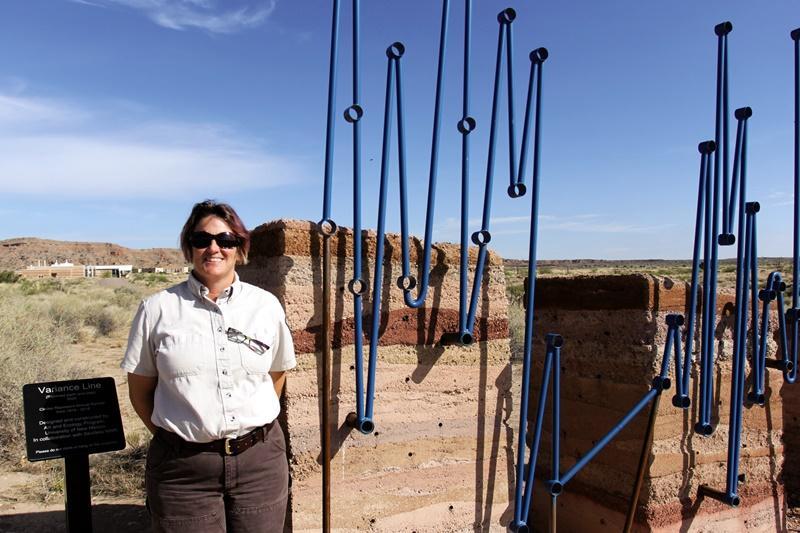
Visitor Services Manager Jeannine Kimble stands in front of an art installation at the refuge; the installation offers a visual representation of declining rainfall in the area over the last 100 years.
Cathy Cook | El Defensor Chieftain photos
The Sevilleta National Wildlife Refuge is a great spot for hiking, learning about New Mexico’s ecosystem and engaging with the natural world. A visit to the refuge is free.
The wildlife refuge hosts monthly educational programs like hummingbird banding, moth nights and falconer visits. There are five miles of hiking on the refuge near the river and eight miles of hiking near the entrance, which can be accessed even if the gate is closed.

A display in the visitors center shows a preserved black bear and mountain lion, both native to the area.
The visitor’s center was closed for 26 months due to COVID-19 but reopened in May.
Located just off of I-25 a few miles north of Socorro, Sevilleta was established as a wildlife refuge in 1973 when the Campbell Family Foundation donated the land to the US Fish and Wildlife Service. The 229,000 acres are home to 89 species of mammals, 251 bird species, 58 species of reptiles, 15 species of amphibians, 1,200 plant species and countless insects.
“As far as diversity goes, every native mammal in New Mexico calls this refuge home, and some non-natives,” said Visitor Services Manager Jeannine Kimble.
The refuge does restoration work to help endangered species in the area, like Willow Flycatchers. The birds like to nest in invasive salt cedar trees because the structure of the tree is similar to the Goodding’s Willow. The refuge gets rid of the salt cedar and replaces it with the Goodding’s Willow or Cottonwoods.
Along with being home to elk, deer, pronghorn, coyotes, mountain lions, hummingbirds and prairie dogs, Sevilleta is home to long term research projects. It is the only national wildlife refuge that hosts long term ecologic research projects and the only New Mexico refuge that participates in the North American butterfly count.

A trail camera captures an image of an elk coming to drink.
Wildlife photos courtesy of Sevilleta.
There are 12 undergraduate students currently assisting on research projects at Sevilleta.
One ongoing research project studies night warming, to help understand how the landscape will change with climate change. Plots are covered with aluminum overnight to trap the heat and uncovered during the day. Another project examines the effects of drought by adding and removing water to specific areas of the landscape to see the impact.
The refuge hosts the Mexican Gray Wolf recovery program on about 200 acres. There are no wolves on Sevilleta not in a pen. The range for wolves in the wilderness is in the Gila. Visitors can learn about the endangered wolf and the recovery program at the visitor’s center. They even have a display on the differences between wolves and coyotes.
“There’s a lot of misidentification between these two species, the coyote and the wolf, and so if you stand here, you can actually take a look at both of them and see some of their differences.”

A golden eagle swoops down to a drinker at Sevilleta
National Wildlife Refuge.
The visitor’s center has displays that educate the public on local geology, the history of the land and native plants.
“When they go home, they can plant natives in their yard and native plants promote healthy habitats for native birds and lizards,” said Kimble. “A lot of times native are low maintenance too.”
The refuge also works with local school children, doing projects like having classrooms raise native fish and then release them into the river.
“These young folks are going to be making important decisions for us in the future and conservation is key. We need to teach them about the environment and things that we can do to better it and how they can become a part of improving it. Getting involved in citizen science is important,” Kimble said.
Upcoming events
- Moth night on Sept. 10
- Butterfly Count in August
- Hawks and falcons of Sevilleta, Sept. 17, 2 to 4 p.m.






















